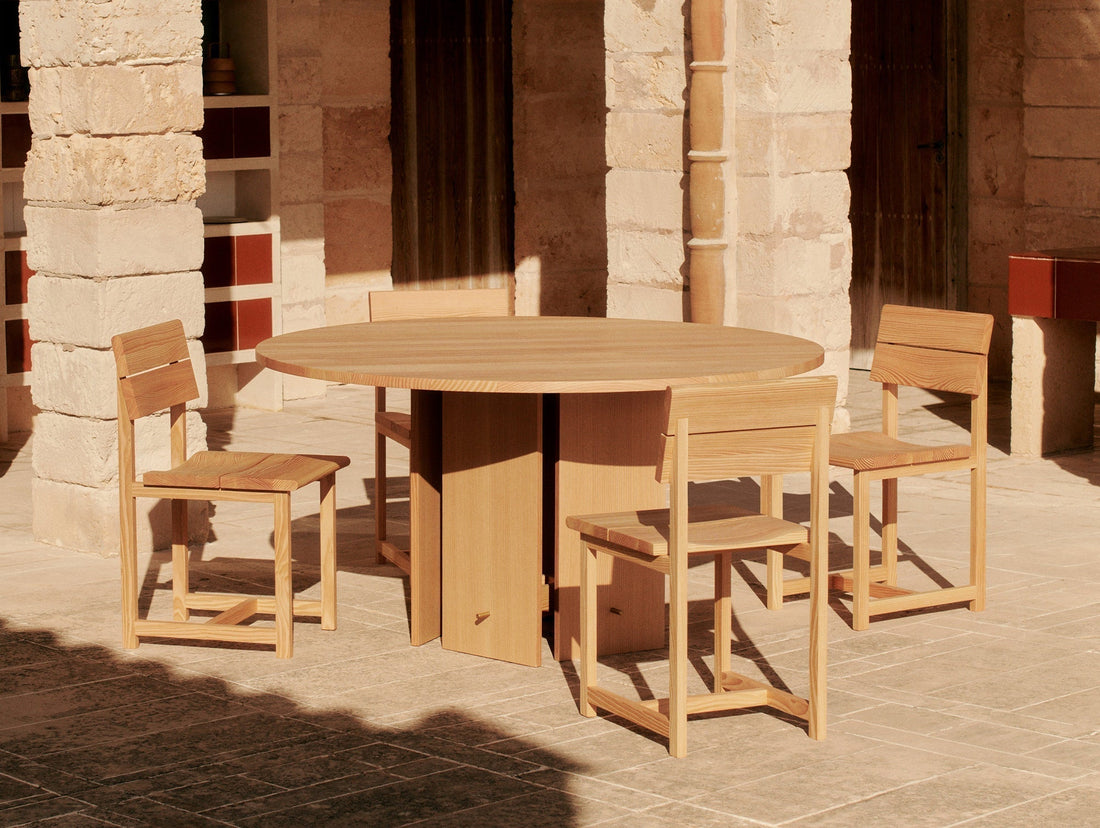After years of being overshadowed by hardwoods, softwoods are slowly finding their place again in the furniture industry. Once seen as too humble for contemporary interiors, they’re now appreciated for their honest character and natural charm, which can bring a sense of warmth, texture and serenity to modern spaces.
Understanding Softwoods
Softwoods come from coniferous trees such as pine, spruce, fir and cedar. These species tend to grow faster and are generally lighter than hardwoods. Despite the name, not all softwoods are soft — many are strong and work well for furniture. Pine and spruce offer warm tones and distinctive grain, while Douglas fir combines beauty with strength. More and more, brands like HAY, Frama, Normann Copenhagen, FDB Møbler and Form & Refine are using softwoods in their collections.
The Quiet Comeback
There’s been a growing interest in lighter, more natural materials in furniture and interior design. Softwoods like pine, spruce and Douglas fir align well with this approach. Their bold grain and warm tones help create a calm and minimal atmosphere. Beyond trends, many designers are focusing on creating pieces that feel honest and are built to last. They choose materials that are not only practical but also visually appealing and able to age beautifully. Thanks to their flexibility and ease of use, softwoods are becoming a popular choice in contemporary design.
Softwoods in Everyday Living
Pine wood is lightweight yet durable, and it absorbs stain or paint well, allowing the natural grain to show through beautifully. Whether left untreated for a raw, organic look or finished in clear or coloured oil, pine retains a visual softness that complements a variety of interior styles.
 Above from top left: HAY Weekday Table and Bench, Form & Refine Beam Wall Shelf 3 and FDB Mobler D108 Side / Coffee Table.
Above from top left: HAY Weekday Table and Bench, Form & Refine Beam Wall Shelf 3 and FDB Mobler D108 Side / Coffee Table.
Pine is more versatile than it might seem. It’s practical, but it also has a quiet, understated beauty. The Form & Refine Beam Wall Shelf expresses this through its pale tone, visible grain and natural knots, which give the piece a soft, organic look. The FDB Møbler D108 Side Table, finished in colour oil, preserves the subtle texture of the wood and avoids visual heaviness. Pine can also be used outdoors when properly treated. The HAY Weekday series, for example, uses a special outdoor coating that maintains the wood’s natural character.
Above from top left: Frama Atelier Chair and AML Stool.
Spruce wood has a similar tone to pine, though it is slightly harder and generally features a more even grain with fewer knots. Both types of wood have a rustic and natural character that suits a wide range of interiors and brings a sense of warmth and simplicity, whether through the fine grain of spruce or the more expressive texture of pine. The Frama Atelier Chair, for example, uses spruce to emphasise a clean and serene aesthetic. Above: Normann Copenhagen Notch Bed Frame
Above: Normann Copenhagen Notch Bed Frame
For those who appreciate minimal design or are looking to create a Japanese-inspired interior, pine furniture offers a thoughtful starting point. Known for its practicality, pine is also strong and durable. Its natural knots add gentle character without disturbing the calm and uncluttered look. No furniture will remain as new forever; the unique pattern of the pine wood will hide any knocks or imperfections, as they are gathered through the years. Traditionally used in Japanese architecture, pine brings a sense of balance through its understated and organic appearance. Above from top left: Normann Copenhagen Plank Bookcase and Stretch Stool
Above from top left: Normann Copenhagen Plank Bookcase and Stretch Stool
Douglas fir is also becoming popular for its distinctive grain pattern and naturally rich, reddish tone, which comes from the heartwood at the centre of the tree. Though it was mainly used for structural purposes, it’s now appreciated in furniture making for its honest character and its balance of strength and lightness. As it ages, its surface develops a subtle patina that adds depth and personality to each piece. The soft knots and distinctive colour variation make every piece feel unique and special. Combined with Douglas fir’s warmth and natural richness, these details suit interiors with a more organic tone, especially where natural materials are preferred over industrial finishes. Above from top left: Ferm Living Sala Piece and Ferm Living Vist Dining Chair
Above from top left: Ferm Living Sala Piece and Ferm Living Vist Dining Chair
Ferm Living uses quarter-sawn lumber, a technique that creates a clearer and more linear grain pattern instead of a bold, flame-like effect. This precise method brings out the natural rhythm of the wood, giving each piece a soft and understated finish. It shows that in furniture making, the way a material is processed can be just as meaningful as the material itself. Above from top left: Ferm Living Douglas fir processing stages
Above from top left: Ferm Living Douglas fir processing stages
Simply lasting beauty
Softwood’s gentle grain and warm tone bring a calm presence to the spaces we live in. It fits naturally into the home, offering warmth and character without overwhelming the room. If you’re looking to introduce a natural element that feels timeless, softwood can be a worthwhile place to start. Unlike hardwoods, which can sometimes feel more formal or heavy, softwood brings something lighter and more relaxed. It’s the kind of material that makes a space feel genuinely lived in and welcoming.

